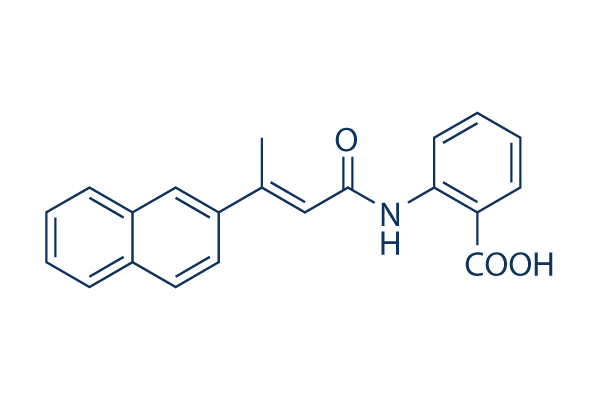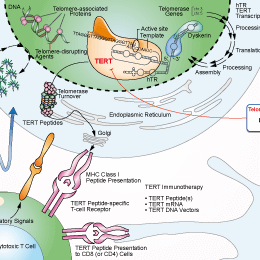
- Bioactive Compounds
- By Signaling Pathways
- PI3K/Akt/mTOR
- Epigenetics
- Methylation
- Immunology & Inflammation
- Protein Tyrosine Kinase
- Angiogenesis
- Apoptosis
- Autophagy
- ER stress & UPR
- JAK/STAT
- MAPK
- Cytoskeletal Signaling
- Cell Cycle
- TGF-beta/Smad
- Compound Libraries
- Popular Compound Libraries
- Customize Library
- Clinical and FDA-approved Related
- Bioactive Compound Libraries
- Inhibitor Related
- Natural Product Related
- Metabolism Related
- Cell Death Related
- By Signaling Pathway
- By Disease
- Anti-infection and Antiviral Related
- Neuronal and Immunology Related
- Fragment and Covalent Related
- FDA-approved Drug Library
- FDA-approved & Passed Phase I Drug Library
- Preclinical/Clinical Compound Library
- Bioactive Compound Library-I
- Bioactive Compound Library-Ⅱ
- Kinase Inhibitor Library
- Express-Pick Library
- Natural Product Library
- Human Endogenous Metabolite Compound Library
- Alkaloid Compound LibraryNew
- Angiogenesis Related compound Library
- Anti-Aging Compound Library
- Anti-alzheimer Disease Compound Library
- Antibiotics compound Library
- Anti-cancer Compound Library
- Anti-cancer Compound Library-Ⅱ
- Anti-cancer Metabolism Compound Library
- Anti-Cardiovascular Disease Compound Library
- Anti-diabetic Compound Library
- Anti-infection Compound Library
- Antioxidant Compound Library
- Anti-parasitic Compound Library
- Antiviral Compound Library
- Apoptosis Compound Library
- Autophagy Compound Library
- Calcium Channel Blocker LibraryNew
- Cambridge Cancer Compound Library
- Carbohydrate Metabolism Compound LibraryNew
- Cell Cycle compound library
- CNS-Penetrant Compound Library
- Covalent Inhibitor Library
- Cytokine Inhibitor LibraryNew
- Cytoskeletal Signaling Pathway Compound Library
- DNA Damage/DNA Repair compound Library
- Drug-like Compound Library
- Endoplasmic Reticulum Stress Compound Library
- Epigenetics Compound Library
- Exosome Secretion Related Compound LibraryNew
- FDA-approved Anticancer Drug LibraryNew
- Ferroptosis Compound Library
- Flavonoid Compound Library
- Fragment Library
- Glutamine Metabolism Compound Library
- Glycolysis Compound Library
- GPCR Compound Library
- Gut Microbial Metabolite Library
- HIF-1 Signaling Pathway Compound Library
- Highly Selective Inhibitor Library
- Histone modification compound library
- HTS Library for Drug Discovery
- Human Hormone Related Compound LibraryNew
- Human Transcription Factor Compound LibraryNew
- Immunology/Inflammation Compound Library
- Inhibitor Library
- Ion Channel Ligand Library
- JAK/STAT compound library
- Lipid Metabolism Compound LibraryNew
- Macrocyclic Compound Library
- MAPK Inhibitor Library
- Medicine Food Homology Compound Library
- Metabolism Compound Library
- Methylation Compound Library
- Mouse Metabolite Compound LibraryNew
- Natural Organic Compound Library
- Neuronal Signaling Compound Library
- NF-κB Signaling Compound Library
- Nucleoside Analogue Library
- Obesity Compound Library
- Oxidative Stress Compound LibraryNew
- Plant Extract Library
- Phenotypic Screening Library
- PI3K/Akt Inhibitor Library
- Protease Inhibitor Library
- Protein-protein Interaction Inhibitor Library
- Pyroptosis Compound Library
- Small Molecule Immuno-Oncology Compound Library
- Mitochondria-Targeted Compound LibraryNew
- Stem Cell Differentiation Compound LibraryNew
- Stem Cell Signaling Compound Library
- Natural Phenol Compound LibraryNew
- Natural Terpenoid Compound LibraryNew
- TGF-beta/Smad compound library
- Traditional Chinese Medicine Library
- Tyrosine Kinase Inhibitor Library
- Ubiquitination Compound Library
-
Cherry Picking
You can personalize your library with chemicals from within Selleck's inventory. Build the right library for your research endeavors by choosing from compounds in all of our available libraries.
Please contact us at [email protected] to customize your library.
You could select:
- Antibodies
- Bioreagents
- qPCR
- 2x SYBR Green qPCR Master Mix
- 2x SYBR Green qPCR Master Mix(Low ROX)
- 2x SYBR Green qPCR Master Mix(High ROX)
- Protein Assay
- Protein A/G Magnetic Beads for IP
- Anti-Flag magnetic beads
- Anti-Flag Affinity Gel
- Anti-Myc magnetic beads
- Anti-HA magnetic beads
- Poly FLAG Peptide lyophilized powder
- Protease Inhibitor Cocktail
- Protease Inhibitor Cocktail (EDTA-Free, 100X in DMSO)
- Phosphatase Inhibitor Cocktail (2 Tubes, 100X)
- Cell Biology
- Cell Counting Kit-8 (CCK-8)
- Animal Experiment
- Mouse Direct PCR Kit (For Genotyping)
- New Products
- Contact Us
BIBR 1532
BIBR 1532 is a potent, selective, non-competitive telomerase inhibitor with IC50 of 100 nM in a cell-free assay. No inhibition of DNA and RNA polymerases, including HIV reverse transcriptase are observed at concentrations vastly exceeding the IC50 for telomerase. BIBR 1532 induces apoptosis in cancer cells.

BIBR 1532 Chemical Structure
CAS: 321674-73-1
Selleck's BIBR 1532 has been cited by 29 Publications
2 Customer Reviews
Purity & Quality Control
Batch:
Purity:
99.99%
99.99
BIBR 1532 Related Products
| Related Compound Libraries | FDA-approved Drug Library Natural Product Library Apoptosis Compound Library DNA Damage/DNA Repair compound Library Cell Cycle compound library | Click to Expand |
|---|
Signaling Pathway
Choose Selective Telomerase Inhibitors
Cell Data
| Cell Lines | Assay Type | Concentration | Incubation Time | Formulation | Activity Description | PMID |
|---|---|---|---|---|---|---|
| human HeLa cells | Function assay | 2 h | Inhibition of telomerase in human HeLa cells after 2 hrs by [alpha-32P]dGTP incorporation assay, IC50=93 nM | 22413845 | ||
| human MDA-MB-231 cells | Function assay | 24 h | Inhibition of telomerase in human MDA-MB-231 cells after 24 hrs by TRAP-PCR-ELISA, IC50=0.17 μM | 25965778 | ||
| human MGC803 cells | Function assay | 24 h | Inhibition of telomerase in human MGC803 cells after 24 hrs by TRAP-PCR-ELISA, IC50=0.28 μM | 25554922 | ||
| HeLa | Function assay | 15 mins | Inhibition of telomerase in human HeLa cells using 5'-AAT CCG TCG AGC AGA GTT-3' as substrate incubated for 15 mins prior to extension reaction by telomeric repeat amplification protocol, IC50=3.6μM | 22413845 | ||
| HeLa | Function assay | 15 mins | Inhibition of telomerase in human HeLa cells using 5'-AAT CCG TCG AGC AGA GTT-3' as substrate incubated for 15 mins prior to extension reaction followed by compound washout by spin-telomeric repeat amplification protocol, IC50=4.6μM | 22413845 | ||
| HeLa | Function assay | 30 mins | Inhibition of human telomerase isolated from human HeLa cells nuclear extracts expressed in insect cells assessed as [33P]dCMP incorporation after 30 mins by liquid scintillation counting analysis, IC50=0.093μM | 24053596 | ||
| HEK293 | Function assay | Inhibition of human telomerase activity isolated from HEK293 cells assessed as reduction in dNTP incorporation using 5'-biotinylated AATCCGTCGAGCAGAGTT primer by flash plate assay, IC50=3.6μM | 27657809 | |||
| Click to View More Cell Line Experimental Data | ||||||
Biological Activity
| Description | BIBR 1532 is a potent, selective, non-competitive telomerase inhibitor with IC50 of 100 nM in a cell-free assay. No inhibition of DNA and RNA polymerases, including HIV reverse transcriptase are observed at concentrations vastly exceeding the IC50 for telomerase. BIBR 1532 induces apoptosis in cancer cells. | ||
|---|---|---|---|
| Targets |
|
| In vitro | ||||
| In vitro | BIBR 1532 exhibits an non-competitive inhibitory effect on telomerase activity. [1] In JVM13 leukemia cell line, BIBR 1532 shows an antiproliferative effect in a dose-dependent range with IC50 of 52 μM, and similar results are also observed in other leukemia cell lines including Nalm-1, HL-60, and Jurkat. In addition, BIBR 1532 results in a direct antiproliferative effect on acute myeloid leukemia (AML) with IC50 of 56 μM without affecting the proliferative capacity of normal hematopoietic progenitor cells. [2] BIBR 1532 (2.5 μM) reduces colony-forming ability, and induces telomere length shortening as well as chemotherapeutic sensitization by inhibiting telomerase activity in MCF-7/WT and melphalan-resistant MCF-7/MlnR cell lines. [3] In T-cell prolymphocytic leukemia (T-PLL), BIBR 1532 shows selective cytotoxic effects in a dose-dependent manner and BIBR 1532-treated cells also demonstrates nuclear condensation and formation of apoptotic bodies morphologically compatible with apoptosis. [4] A recent study shows that combination treatment of BIBR 1532 and chemotherapeutic agents carboplatin results in a potential synergy for eliminateing ovarian cancer spheroid-forming cells in ES2, SKOV3, and TOV112D cell lines. [5] | |||
|---|---|---|---|---|
| Kinase Assay | Conventional Telomerase Assay | |||
| For the direct telomerase assay with the endogenous telomerase, 10 μL of telomerase-enriched extract is mixed with different concentrations of BIBR1532 in a final volume of 20 μL. After 15-minute preincubation on ice, 20 μL of the reaction mixture is added, and the reaction is initiated by transferring the tubes to 37 °C. The final concentrations in the reaction mixture are 25 mM Tris-Cl (pH 8.3), 1 mM MgCl2, 1 mM EGTA, 1 mM dATP, 1 mM dTTP, 6.3 μM cold dGTP, 15 μCi [α-32P]dGTP (3000 Ci/mmol; NEN), 1.25 mM spermidine, 10 units of RNasin, 5 mM 2-mercaptoethanol, and 2.5 μM TS-primer (5 | ||||
| Cell Research | Cell lines | JVM13 | ||
| Concentrations | 0 to 80 μM | |||
| Incubation Time | 24 -72 hours | |||
| Method | Cells are plated as triplicates in complete RPMI 1640 medium with various concentrations of BIBR1532. After 24 to 72 hours, water-soluble tetrazolium (WST-1) is added, which is transformed into formazan by mitochondrial reductase systems. The increase in the number of viable cells results in an increase of activity of mitochondrial dehydrogenases, leading to an increase of formazan dye formed, which is quantified by ELISA reader after 2, 3, and 4 hours of incubation. |
|||
Chemical Information & Solubility
| Molecular Weight | 331.36 | Formula | C21H17NO3 |
| CAS No. | 321674-73-1 | SDF | Download BIBR 1532 SDF |
| Smiles | CC(=CC(=O)NC1=CC=CC=C1C(=O)O)C2=CC3=CC=CC=C3C=C2 | ||
| Storage (From the date of receipt) | |||
|
In vitro |
DMSO : 66 mg/mL ( (199.17 mM); Moisture-absorbing DMSO reduces solubility. Please use fresh DMSO.) Ethanol : 16 mg/mL Water : Insoluble |
Molecular Weight Calculator |
|
In vivo Add solvents to the product individually and in order. |
In vivo Formulation Calculator |
||||
Preparing Stock Solutions
Molarity Calculator
In vivo Formulation Calculator (Clear solution)
Step 1: Enter information below (Recommended: An additional animal making an allowance for loss during the experiment)
mg/kg
g
μL
Step 2: Enter the in vivo formulation (This is only the calculator, not formulation. Please contact us first if there is no in vivo formulation at the solubility Section.)
% DMSO
%
% Tween 80
% ddH2O
%DMSO
%
Calculation results:
Working concentration: mg/ml;
Method for preparing DMSO master liquid: mg drug pre-dissolved in μL DMSO ( Master liquid concentration mg/mL, Please contact us first if the concentration exceeds the DMSO solubility of the batch of drug. )
Method for preparing in vivo formulation: Take μL DMSO master liquid, next addμL PEG300, mix and clarify, next addμL Tween 80, mix and clarify, next add μL ddH2O, mix and clarify.
Method for preparing in vivo formulation: Take μL DMSO master liquid, next add μL Corn oil, mix and clarify.
Note: 1. Please make sure the liquid is clear before adding the next solvent.
2. Be sure to add the solvent(s) in order. You must ensure that the solution obtained, in the previous addition, is a clear solution before proceeding to add the next solvent. Physical methods such
as vortex, ultrasound or hot water bath can be used to aid dissolving.
Tech Support
Answers to questions you may have can be found in the inhibitor handling instructions. Topics include how to prepare stock solutions, how to store inhibitors, and issues that need special attention for cell-based assays and animal experiments.
Tel: +1-832-582-8158 Ext:3
If you have any other enquiries, please leave a message.
* Indicates a Required Field
Frequently Asked Questions
Question 1:
Does BIBR1532 diffuse through the plasma membrane and nuclear membrane?
Answer:
BIBR1532 is a cell permeable molecule.
Tags: buy BIBR 1532 | BIBR 1532 supplier | purchase BIBR 1532 | BIBR 1532 cost | BIBR 1532 manufacturer | order BIBR 1532 | BIBR 1532 distributor








































